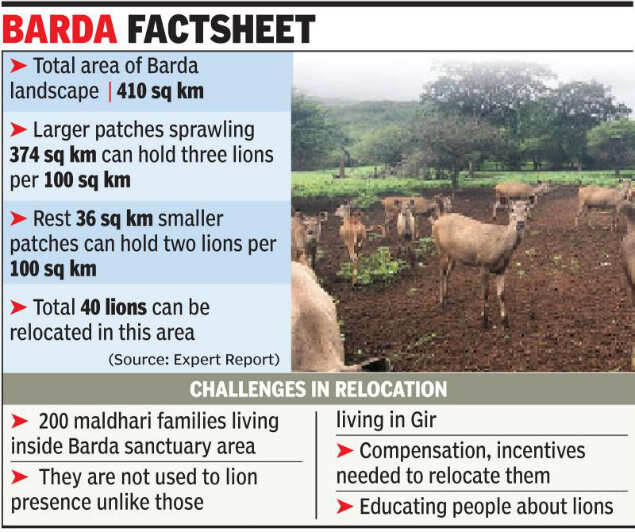RAJKOT:
Five years after setting up breeding centres for sambar and spotted
deer, the forest department is all set to release 160 animals inside the
Barda sanctuary as an important step to relocate Asiatic lions who have
made the coastal belt near Porbandar their permanent home.

Sambars and chital (spotted deers) are the important prey base for lions and they were bred at Killeshwar centre set up near Barda in 2014. Forest department officials said they currently have 55 sambars in Killeshwar and 95 spotted deer in Sat Virda area and all these will be released in the sanctuary area soon.
Chief conservator of forest (wildlife circle), DT Vasavada said, “When lion population increases near Keshod and Mangrol, they will require new space and move towards Barda in the next three to five years. We are preparing the future prey base for lions.”
Lions were seen near Madhavpur village of Porbandar before few months and their sightings have become fairly common along the coastal belt from Mangrol to Madhavpur. In fact, this stretch is considered to the potential natural corridor for lions to move to Barda.
Lion expert YV Jhala, who had submitted a report regarding translocation of lions in Barda, told TOI: “Lions will have to be brought in with proper planning. You can’t wait for the lions to colonize in the areas where they are moving. This is because two or four lions don’t make a population.
Experts have welcomed the decision to release deer, but they have emphasized on prioritizing systematic relocation of the human population, mostly maldharis (cattle breeders), living inside the sanctuary area.
According to Jhala, maldharis in Barda are not used to dealing with lions like the cattle breeders in Gir national park do. We have therefore recommended that they be given proper compensation and incentives just like it was done in the tiger reserve.”
Priyvrat Gadhvi, a member of state wildlife board said, “In terms of carnivores, prey base is most important factor which will determine whether they would coming into conflicts with humans. At the same time, the forest department will also have to address the presence humans habitants.”
Vasavada, however, said, “When lions were seen near Madhavpur, we educated locals. Just as lions adjusted with humans in Gir, it would happen here too with sustained awareness and education campaigns.”
https://timesofindia.indiatimes.com/city/rajkot/160-deer-to-be-released-in-barda-as-prey-for-lions/articleshow/70666493.cms

Sambars and chital (spotted deers) are the important prey base for lions and they were bred at Killeshwar centre set up near Barda in 2014. Forest department officials said they currently have 55 sambars in Killeshwar and 95 spotted deer in Sat Virda area and all these will be released in the sanctuary area soon.
Chief conservator of forest (wildlife circle), DT Vasavada said, “When lion population increases near Keshod and Mangrol, they will require new space and move towards Barda in the next three to five years. We are preparing the future prey base for lions.”
Lions were seen near Madhavpur village of Porbandar before few months and their sightings have become fairly common along the coastal belt from Mangrol to Madhavpur. In fact, this stretch is considered to the potential natural corridor for lions to move to Barda.
Lion expert YV Jhala, who had submitted a report regarding translocation of lions in Barda, told TOI: “Lions will have to be brought in with proper planning. You can’t wait for the lions to colonize in the areas where they are moving. This is because two or four lions don’t make a population.
Experts have welcomed the decision to release deer, but they have emphasized on prioritizing systematic relocation of the human population, mostly maldharis (cattle breeders), living inside the sanctuary area.
According to Jhala, maldharis in Barda are not used to dealing with lions like the cattle breeders in Gir national park do. We have therefore recommended that they be given proper compensation and incentives just like it was done in the tiger reserve.”
Latest Comment
Relocation of villages
deepak pratap gangwar
See All CommentsAdd comment
Priyvrat Gadhvi, a member of state wildlife board said, “In terms of carnivores, prey base is most important factor which will determine whether they would coming into conflicts with humans. At the same time, the forest department will also have to address the presence humans habitants.”
Vasavada, however, said, “When lions were seen near Madhavpur, we educated locals. Just as lions adjusted with humans in Gir, it would happen here too with sustained awareness and education campaigns.”
https://timesofindia.indiatimes.com/city/rajkot/160-deer-to-be-released-in-barda-as-prey-for-lions/articleshow/70666493.cms
No comments:
Post a Comment